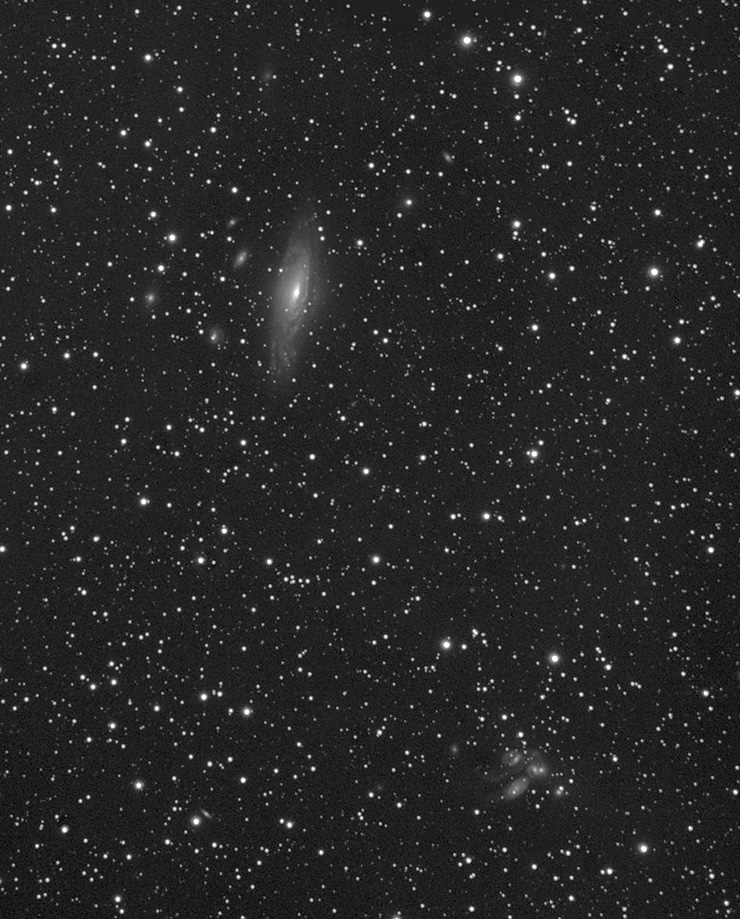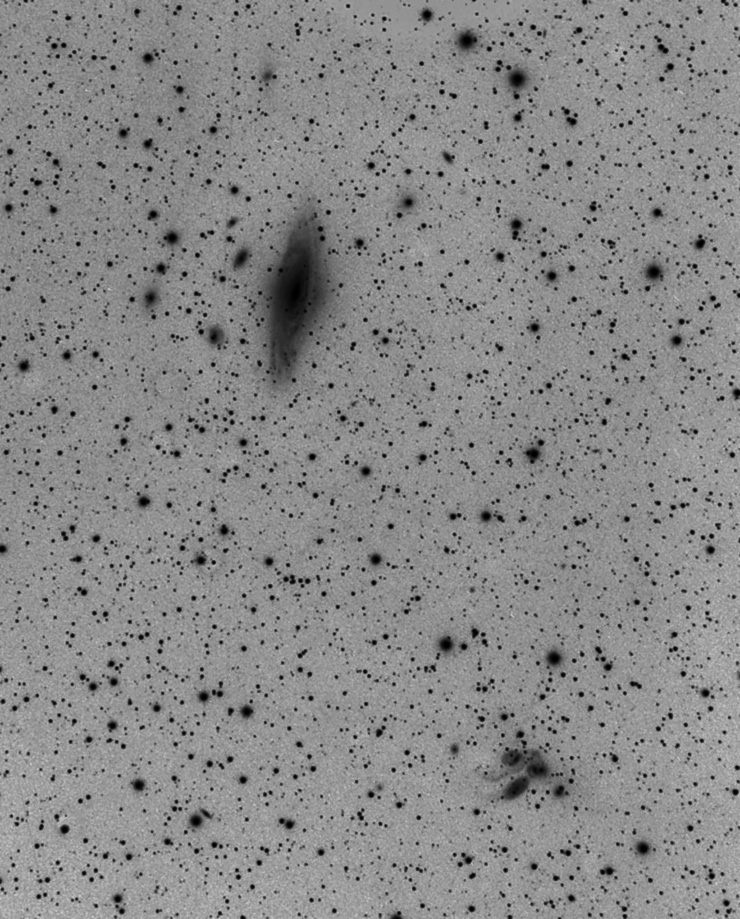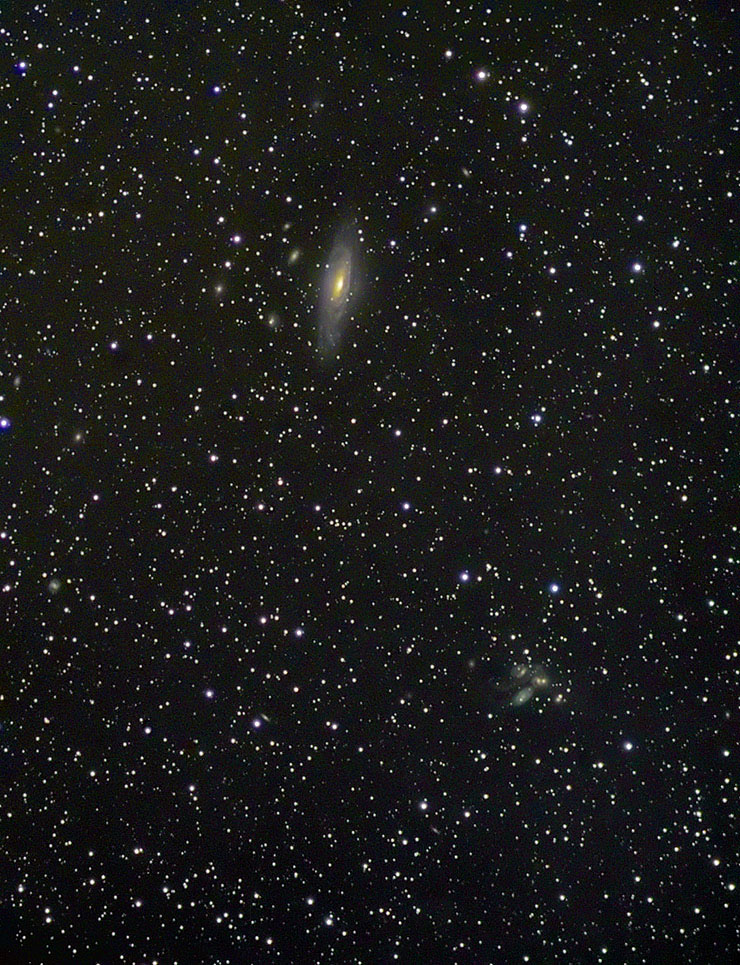|
12/5/2010: The weather outside is frightful, but I don't care. The remote control software works just fine. Temperatures are headed for the low 20's and the wind may gust to 30mph (although down here under the pines, I would be surprised if even the most determined vespers come anywhere near that). Clear skies at sunset made trying out the remote setup irresistable. I calibrated on Deneb, slewed to NGC 7331, focused the CCD in L, and then beat it indoors. There I set about trying to do a color photo of big and bright NGC 7331 and the fainter, smaller members of Stephan's Quintet and the Deerlick Group. I had two hours of luminance data before 8:30. Look:
NGC 7331, The Deerlick Group,
and Stephan's Quintet: a field full of galaxies in Pegasus
Quite a contrast with the visual experience! In a 17.5-inch Coulter masked to 16 (to hide a turned edge of some sort), the Quintet is easy enough under dark skies. It's a messy / intriguing cloud of light with multiple cores tucked into a dim starfield a starhop from NGC 7331. Because clouds thwarted my attempts to get solid RGB data to complement the luminance channel, here's L again, reversed and stretched without mercy to show tidal streams within Stephan's Quintet. The Quintet is the tight group at lower right; you might recognize them in the photo above as the talking angels at the beginning of "It's a Wonderful Life."
Looks like there might be a faint and very long streamer running up and right of the three outer Deerlick galaxies, too. The faintest galaxies in the full frame are catalogued at below 18th magnitude. The tidal streams within the Quintet would make me doubt that the galaxy at the 8 o'clock position is a foreground object. But its red shift, its brightness, and the brightness of type 1 supernovae observed within it pretty well scotch the case for it being at the same distance as NGC 7331 and its associated galaxies at the top of the frame. It, and they, are about 42 million light-years away and not 260 - 300 million light-years like the rest of the Quintet and the small galaxies scattered across the field. (For a different interpretation, see Halton Arp.) So there I was sitting warm and happy at the computer, monitoring the guide camera in PHD and the progress of data collection in Nebulosity 2. Quite suddenly, the guide window started showing a bright fields and relatively few stars. Clouds. Then more clouds. I got decent red data (2x900s) but right after that the sky began to close down. I gave up after a couple of tries to collect similar green frames. Instead, I stopped color imaging and asked instead for fresh darks of 900s and 300s. I needed new darks anyway because I was shooting with the chip cooled to minus 40, which is ten degrees colder than before. It makes a difference! I kept an eye on the guide camera during the darks. I thought there was a good chance of slipping in some shorter color frames. So after shooting darks, I made a few tries and eventually got enough clear air to collect single 300s images in each color channel. Even those short exposures are compromised by strong gradients made by clouds lit from below and blowing through the frame. Here's a heavy-handed combination of color and luminance data. I worked up a thin RGB image in Maxim and combined it in Photoshop with the luminance image. As a finished photpgraph, it's not so hot, but it does demonstrate how little color data is required to get started on an LRGB image and how forgiving the process can be:
8x900s L, 1x300s RGB (2hrs in luminance + 5m in each color)
In color, it's a lot easier to believe that the brightest "member" of the Quintet is significantly different from the others. It begins to look like a bluer galaxy superimposed on an interacting cluster of others far away, which, by better evidence, is exactly what it is. By the time I snuck in those short color frames, the field was slipping down in the west. The only thing clear was that I wasn't going to get more color data tonight. I went outside to turn off and cover the telescope and to collect the computer. At that moment, the Meade DSI guide camera was still showing a good field of stars, so I was amazed to see that the sky appeared to be almost completely overcast. Only Jupiter was visible, shining dimly through trees in the southwest. I could see darker regions here and there near the horizon that probably indicated relatively clear skies, or perhaps they were just out of the range of Valdese's lights. I would never have dreamed it might be possible to make photos under such a sky. And yet... the guider was soldiering on, guiding more often than not, and the CCD was still producing recognizable (although practically useless) images of the selected field. File that away for reference. Notes: The rig suffered one small glitch. The on/off timer is on the fritz. Why? I had to take it out of the mix in order to get power to the telescope drive. This reminds me that it would be better to learn to set horizon and move limits using the Mach1's facilities. This would be a good frame to flatfield. Try to get a flat before moving anything. And BTW, if you decide to shoot color after rotating or dismounting the CCD, it was set to zero degrees of rotation tonight. |
:: top ::
© 2010, David Cortner


